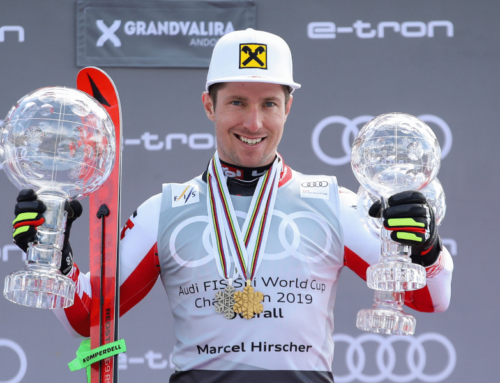Windingstad Makes Up Time For First Win
Monday night’s parallel giant slalom in Alta Badia was an exciting close to a difficult weekend in the Dolomites of Northern Italy. Both Rasmus Windingstad and Roland Leitinger stepped up onto the World Cup podium for the first time in their careers, and Stefan Luitz made his first podium play after a controversy in Beaver Creek stripped (then reinstated) his only win of the 2018/19 season.
Weather caused the legendary Val Gardena downhill to be canceled Saturday, and then it tore apart the Gran Risa on Sunday during the classic giant slalom stop, creating a bumpy ride for the men on an already challenging pitch. The big question going into Monday was whether or not the course would hold up until the big and small finals. During the qualifying rounds hosted earlier in the day, a few key turns in the course were already falling apart, providing some issues for the men as they headed into the first jump of the course.
The USA’s Steven Nyman, a downhill and super-G skier, decided to hop into the parallel races after Ted Ligety chose to sit it out to preserve his back. Nyman hopped on the phone with NBC announcers, Steve Schlanger and Steve Porino, to give them a full course report after he did not qualify for the main parallel event. According to Nyman, the winner of Monday’s parallel race would be a bigger guy that could put up a fight in soft conditions, and find the will to push through and ride out the bumps that would surely develop over the course of the day. Going into the main event, course setters readjusted both the blue and red courses, making the set a bit straighter in order to avoid deterioration.
Windingstad is not a big guy by any means. But the 26-year-old Norwegian did put a big fight. Coming out of the second jump in the big final, Windingstad actually looked to be behind Luitz. Maybe he was lucky to have been seeded on the red course, which seemed to be running a bit faster in the last section. Or maybe, Windingstad wanted the win more and was able to turn it around enough to pull ahead of Luitz by a couple of hundredths. Either way, a win was a surprise for both himself and his team. In parallel training earlier in the week, Windingstad said he was definitely not the fastest.

“I mean I can’t say I’ve been expecting to win any time soon,” said Windingstad. “This ladder you try and climb as a skier or an athlete in general… you have to be as honest as possible with yourself in terms of potential and possible goals. Today I got some confidence from beating [Aleksander] Kilde, and I felt really good that run, and from there on out, I just tried to ski normal.”
The parallel discipline has gone under some scrutiny from long-time ski racers and fans, but there is no denying that the format (while hard on the athletes) is entertaining for the fans to watch. Parallel plays to a different kind of skier. Unlike in traditional disciplines, like giant slalom and the slalom, each parallel raced hosted on the men’s tour thus far has never seen the same guys on the podium. In fact, the only man who has made ever found himself on the parallel GS podium twice is Norway’s Kjetil Jansrud. In the last five parallel GS events hosted on the World Cup, there has been a different winner every time.
“As always, it was a lot of fun,” said second-place finisher Luitz. “I really love the parallel giant slalom. The start is a lot of fun and it’s man versus man next to each other. It’s a really cool format, especially for the spectators. They get to see a live battle in front of them.”
A different kind of pressure is put on the athletes when racing side-by-side with their opponent. While they may not be able to see the man skiing directly to the left or right of them, they can most definitely feel them. Not to mention, courses typically last around 20 seconds, a sprint in comparison to the technical courses the men are used to racing in the traditional disciplines. Parallel, in turn, opens up the podium for different athletes to shine.
On Monday, the Norwegians shone as a team. When Windingstad came through the finish to take the win, the entire team and coaching staff had stuck around and were banging on the finish corral buffer, cheering on their teammate at a volume that could be heard above the massive crowd. The Norwegian men had filled four out of the eight slots going into the quarter-final round and had seven total men finish within the top 30 in the final results of the day. University of Denver alumni, Leif Haugen-Nestvold finished fourth. Young up-and-comer Lucas Braathen, finished fifth. Sunday’s giant slalom winner Henrik Kristoffersen finished seventh.
“My team is more than 80% of the reason I’m here,” said Windingstad. “I probably would have quit many years ago if it wasn’t for our chemistry.”

Another notable finish came from Monday’s third-place podium finisher, Roland Leitinger, a 28-year-old Austrian that knocked out Henrik Kristoffersen out of the race for the Big Final in the quarter-final. Leitinger also stepped onto the World Cup podium for the first time. In 2017, Leitinger finished second in the World Championship giant slalom in St. Moritz, Switzerland, but has been able to find the same speed on the World level since.
“I worked hard for this, and now everything is worth it,” said Leitinger. “After 2017, I started like bib 50, and I skied okay, and now the speed is back and I’m really happy for that.”
Mattias Roenngren, Swedish skier and boyfriend to slalom superstar, Anna Swenn-Larsson had his career-best finish, ending the day in sixth, losing to Braathen in the small final.
Americans Tommy Ford, Ryan Cochran-Seigle, and River Radamus all scored points by the conclusion of the parallel slalom. Both Radamus and Cochran-Seigle made it through the last elimination round to the Round of 16, although neither made it to the quarter-final. Cochran-Seigle was knocked out in the Round of 8, and finished the day ranked 12th. Radamus finished the day in 14th. Radamus beating out Sunday’s giant slalom podium finisher, Zan Kranjec of Slovenia to earn the second set of World Cup points in his career. Despite not making the Round of 8, the 21-year-old is still proud of his performance.
“I felt like I’ve been knocking on the door all season, and it feels great to get a little breakthrough here,” said Radamus. “This is an awesome event, and I’m psyched to have put a few good runs together under the lights tonight. I’m hungry to keep the momentum rolling into the next races in January.”
After the holiday, the men’s tour will reconvene in Bormio for two downhill races and an alpine combined. The next stop for the men focused on the technical disciplines will be in Zagreb for the night slalom events the first weekend of January.
Top 8
- Rasmus Windingstad (NOR)
- Stefan Luitz (GER)
- Roland Leitinger (AUT)
- Leif Haugen-Nestvold (NOR)
- Lucas Braathen (NOR)
- Mattias Roenngren (SWE)
- Henrik Kristoffersen (NOR)
- Justin Murisier (SUI)
For full race results, click here.





















